I’ve finally finished my Edwardian S-bend corset! Yay! It took a couple of years – from drafting/ adapting the pattern to finding the perfect fabric and notions and sewing the corset – but now it’s finished. And I love how it turned out!
‘A perfectly fitting corset is the foundation for artistic dressing.’ (Talk Upon Practical Subjects, 1895)
While in the Edwardian era, this type of corset was known as “straight-front corset” or “erect-form corset”, today it’s usually called “S-bend corset”. This Edwardian corset is heavily boned and was worn for special occasions, such as afternoon garden parties, the theater and evening receptions.
Related: Edwardian Sports Or Ribbon Corset
Edwardian S-Bend Silk Corset
Foundation For The Dress
‘The corset furnishes the foundation for proper dressing. No woman wishes to look like a shapeless dowdy. To obtain a smooth and artistic fitting dress waist she must have the proper foundation to build on, and nothing furnishes this better than a light, smoothly fitting corset that conforms to every line of the body.’ (Talk Upon Practical Subjects, 1895)
The Edwardian S-Bend Corset
‘The introduction of the Erect Form or Straight Front Corset marks a revolution in the Corset trade. It represents the highest art yet attained in the manufacture of Corsets. It means a natural conformation of the Corset to the figure, giving ease and comfort to the wearer, and a chic, graceful effect to the body.
With this Corset there is no binding, no short breathing, because every line is adapted to the figure. By it all the pressure is thrown on the hips and back muscles, thus holding the body erect and straight, and giving it a fine military carriage.’ (Daily Mail And Empire, 1900)
The Fabric
Corsets are usually made of two layers: I used white 100% silk satin fabric for the outer layer of my S-bend corset, while the inner layer is white 100% cotton twill. Both were popular corset fabrics in the 1900s.
‘Imported corsets are the most expensive of the ready-made kinds, but when made “to order” the highest prices are reached. Ordinary women will get along with a couple of corsets a year, costing $3, but when it comes to corsets made of silk or satin, and trimmed with costly lace and made to suit certain whims or different costumes, the cost becomes a very considerable item.’ (A Complete Dictionary of Dry Goods, 1892)
The Pattern
I adapted an original 1901 corset pattern from the book Period Costume For Stage & Screen by Jean Hunnisett.
‘Corsets, like other ready-made clothing are made of all sorts and sizes, and from all prices from 25 cents to $50 each. A full “size” of a corset means 1 inch, expressed 18, 19, 20 up to 40, and representing the actual waist measure of the wearer.’ (A Complete Dictionary of Dry Goods, 1892)
If you want to make your own Edwardian S-bend corset, here‘s a free 1908 corset pattern (scroll down, it’s the second last pattern).
My Inspiration
My main inspiration was this pretty ca. 1907 white silk satin corset at the MET and this Edwardian photograph of a woman wearing a straight-front corset. And you’ll find even more inspiration on my pinterest board ‘1900s Lingerie’:
The Boning
As I’ve mentioned before, my Edwardian S-bend silk corset is heavily boned. Especially the front of this corset style has to be flat and straight, hence the name “straight-front corset”. Therefore I used an extra wide steel busk and rigid metal boning for the front of the corset.
‘Straight front, military erect figure […] with extra heavy front 10-inch steel boned underneath, making a perfectly smooth surface.’ (Sears & Roebuck Catalogue, 1900s)
And for the sides and back I used German plastic boning. As you may know, German plastic boning is less rigid than metal boning and the best substitute for whalebone.
‘Formerly corsets depended for their stiffness entirely upon whalebone, but when gas and coal oil destroyed the whale fishery and whalebone grew scarce and expensive, steel was introduced and substituted for whalebone. This was good for the fronts, but has never been available for the small bones at the sides.
The principal substitute for whalebone is horn. This is chiefly manufactured in France from South American horns, and the stuff is imported cut into narrow strips ready for use. Efforts have been made to substitute celluloid, various kinds of wood and hard rubber strips, but nothing has yet been found so good as the whalebone or the horn.’ (A Complete Dictionary of Dry Goods, 1892)
Metal Eyelets & Lacing
This is the first corset with metal eyelets, because all my other corsets have hand-sewn eyelets. I didn’t like setting the grommets with a hammer because it’s so loud and takes a long time. However, I like how they turned out!
The laces of my Edwardian S-bend silk corset are white, flat, 100% silk ribbons. Today, corset laces are usually round and made of polyester or cotton. But in the Edwardian era it was recommended to use flat silk corset lacing, like on this antique Edwardian silk corset. Corset laces should be ‘made of silk. Silk is more expensive than cotton, it is true, but it wears well and is very comfortable.
The round cords that are substituted for silk ones in cheap corsets hurt the spine […], mark the lingerie, and produce a feeling of discomfort. The flat cotton laces are better, but the flat silk ones are the best. […] They can be pulled in much more easily than cotton ones, and retain their place when tied in a bow. Furthermore they “give” with every movement of the figure, and add, therefore, to the grace of the wearer as well as to her comfort’ (Every Woman’s Encyclopaedia, 1910-2).
The Trimming
Because Edwardian corsets were usually heavily trimmed with lace, I trimmed my corset with cotton Maline lace. Maline lace is similar to Valenciennes lace but softer. I sewed together two Maline laces by hand and threaded the lace with pink, 100% silk ribbon, as on this 1905 silk corset at the MET. I also formed pink silk ribbons into bows to trim the front of the corset and the garters.
Garters
Garters were attached to all Edwardian corsets to hold the stockings up and the corset down. In the Edwardian era, garters were usually trimmed with lace or silk ribbon bows.
‘The hose supporters attached to corsets mean much to a woman’s figure, too. It would seem that their sole purpose is to hold up the hose, when, in reality, they are most needed to hold the corset down, in order to avoid the formation of a ridge at the lower edge.’ (Corsets And Close-Fitting Patterns, 1915)
Tight-Lacing
‘A perfectly fitting corset is the foundation for artistic dressing. This does not imply that the corset should be worn so tight as to contract the waist to an abnormally small size. True beauty combines symmetry with proportion. Broad shoulders and prominent hips, combined with an abnormally small, wasp-like waist, present a figure that is a monstrosity.’ (Talk Upon Practical Subjects, 1895)
Does Wearing A Corset Hurt?
‘Sensible women (and to-day these are legion) do not lace tightly; and if a corset is properly constructed so as to fit every part of the body and not to press upon any one organ more than another, it is a source of comfort and not torture.’ (Talk Upon Practical Subjects, 1895)
‘Many ladies complain that a corset “hurts” them over the hips or at the end of the breast bone. If it were adapted to their figures it would not hurt. A corset should be fitted just as much as a shoe, and both can inflict an immense amount of suffering if they are not adapted to the shape.’ (Beauty: Its Attainment And Preservation, 1896)
More Edwardian Lingerie
Please Pin It!
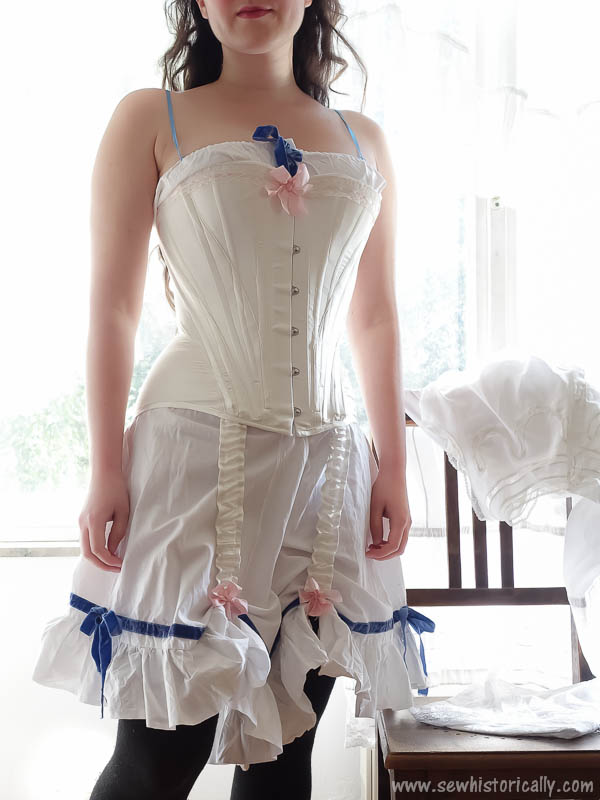
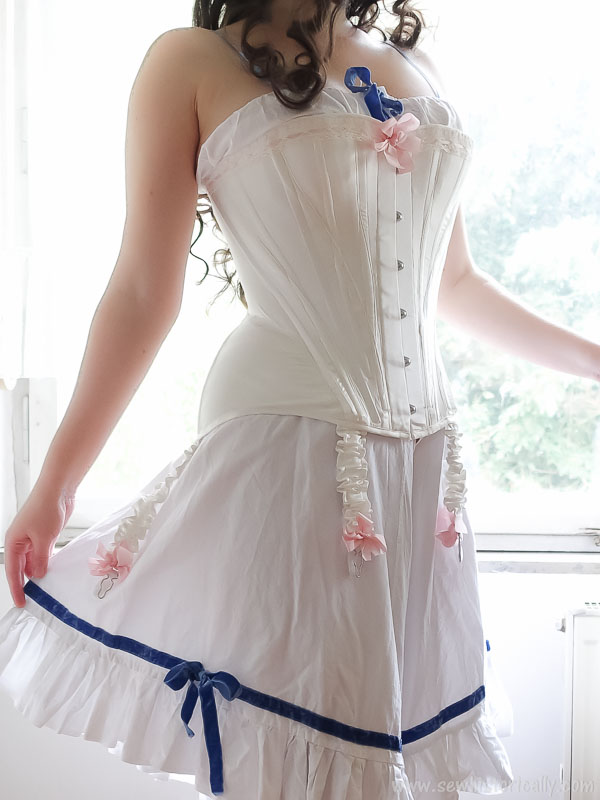
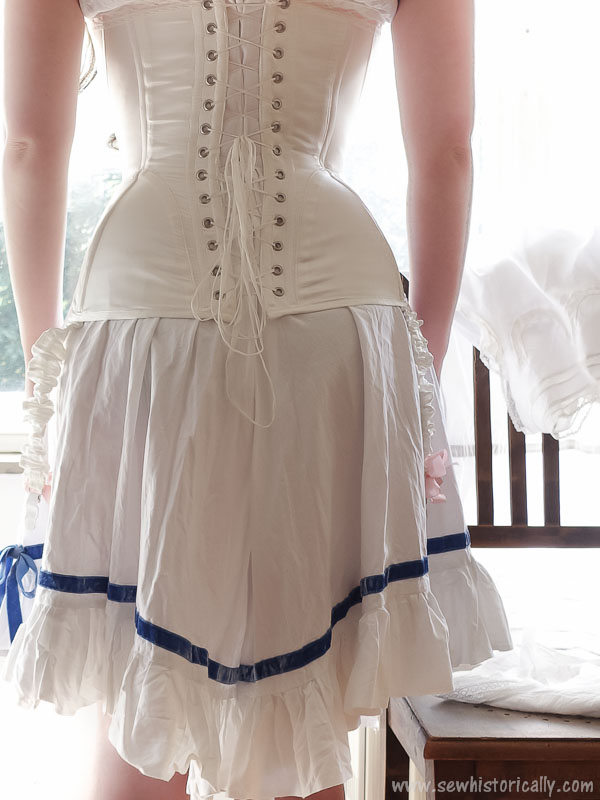
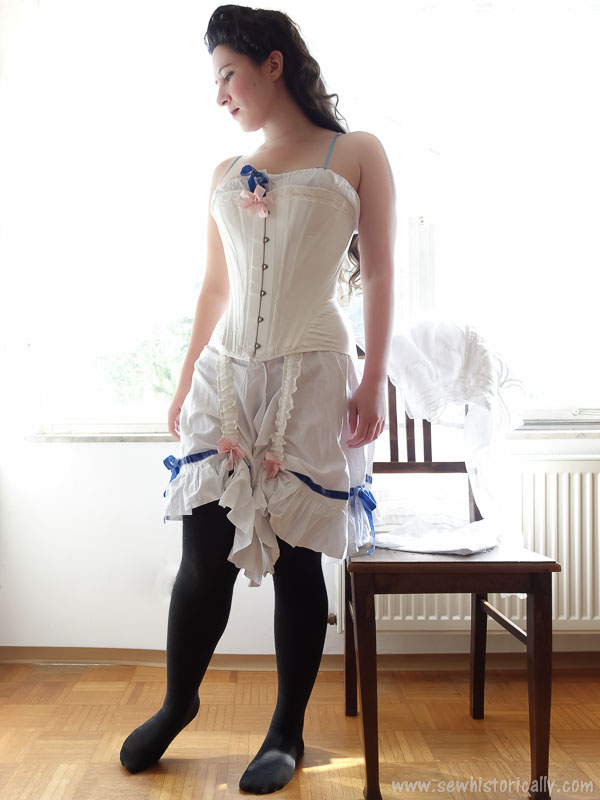
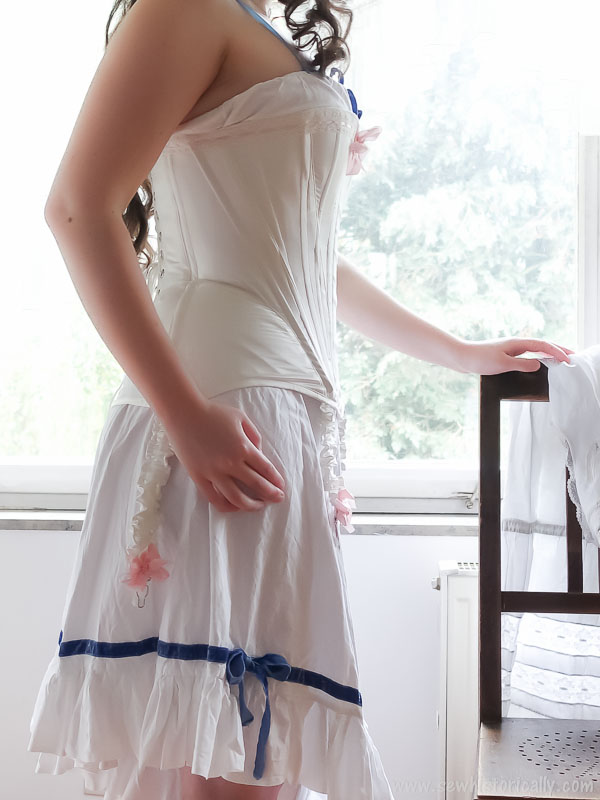
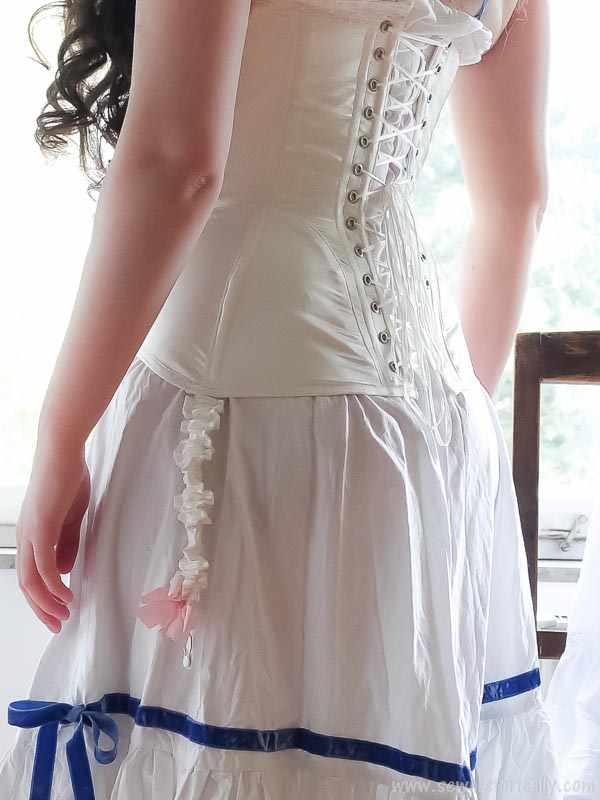
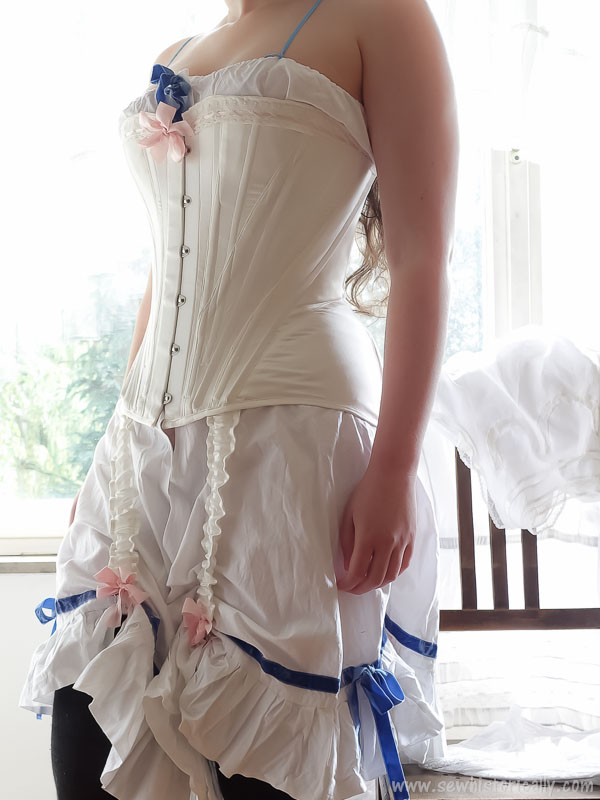
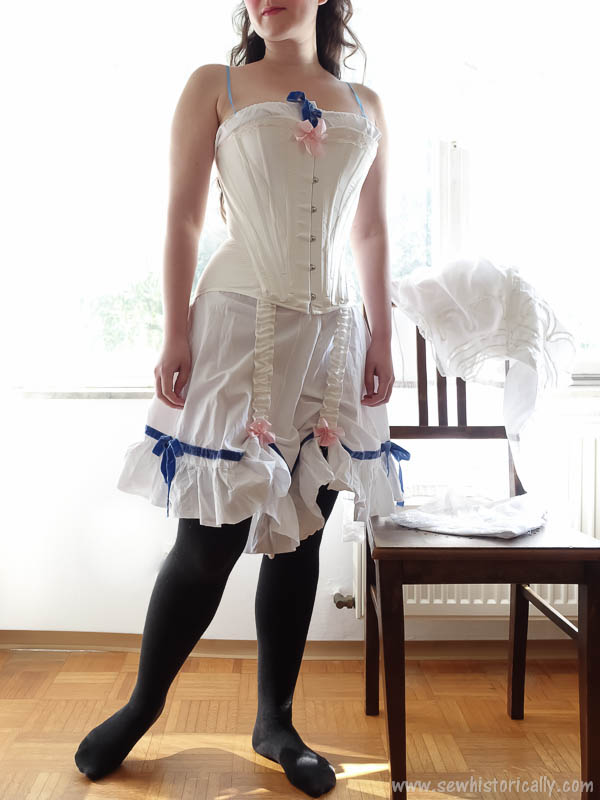

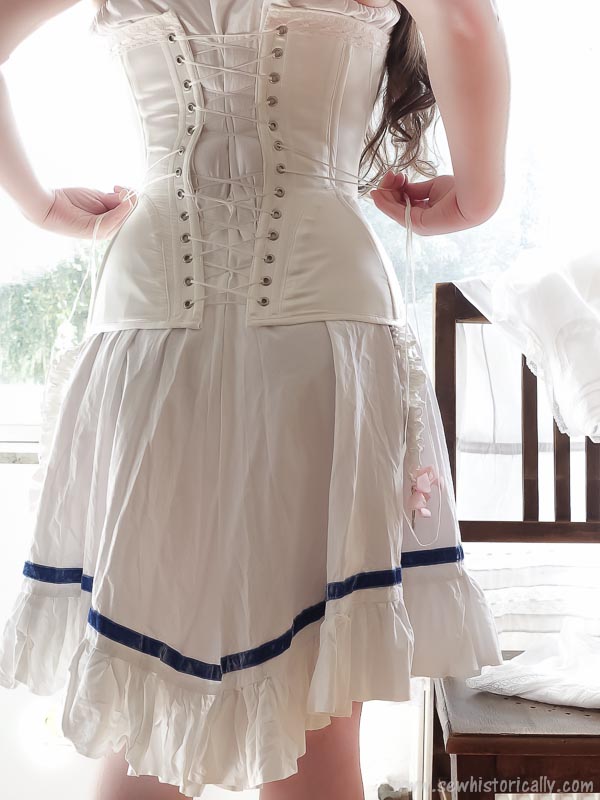

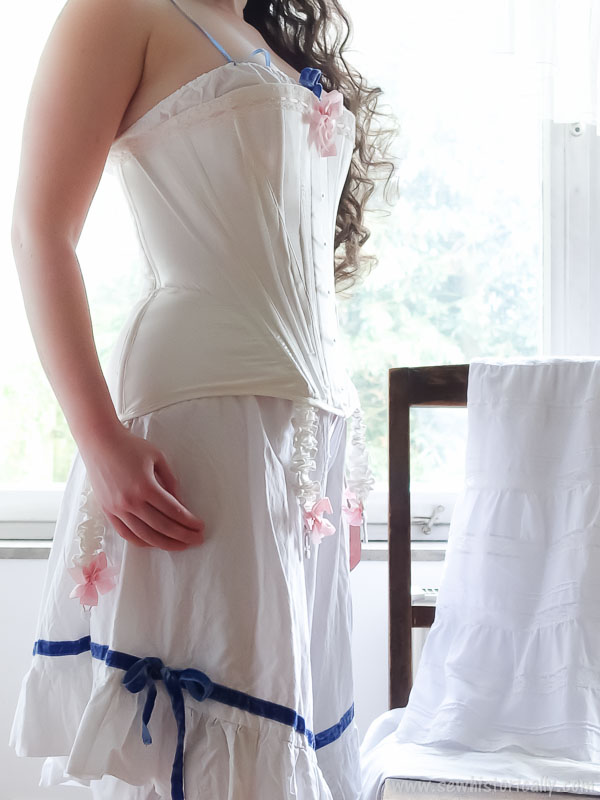
Hi
I love your work. And I appreciate all your well-made blog posts. I’m about to make an Edwardian corset myself and I would like for it to have garters, but I can’t seem to find a place to buy it or how to make it. What did you do for your garters?
And the silk ribbon lacing, is there anything specific to look for, or will any flat silk ribbon do?
Thank you so much! 😀 I made the garters myself: It’s just ordinary elastic covered with fabric. I followed this tutorial to make my garters except that I used silk fabric cut on the straight grain.
And yes, I simply use strong flat silk ribbon as corset laces.
Thank you for your response. I think my corset endeavors will be so much more enjoyable now with all this pretty silk. <3
My only issue with your corset is it doesn’t seam to have a single bend or curved line in it. It looks conical and totally flat at the front. All the curved Victorian corsets I have Sean have …well…an s shaped curve life a human body. Did the pattern not have curves or are you particularly uncorvy and changed the pattern? Its very nice but every bone looks dead flat theres no bulge anywhere I can see and no concavity either except obviously that the hips curve out… I thought it was meant to be more like a vase or like a curvy torso shape?
There is a difference between Victorian and Edwardian corsets: Victorian corsets had a curved front but this was unfashionable in the Edwardian era. The fashionable “New Figure” in the Edwardian era was perfectly flat at the front from the bust down to the hem (or flounce) of the skirt. And I’m naturally very curvy, so it’s really difficult to recreate the fashionable Edwardian straight-front silhouette! 😉 For this corset, I had to use an extra wide stainless steel corset busk because ordinary corset busks bend too much. So, thank you so much: when you say the corset is totally flat at the front, it means that it turned out alright because reproduction Edwardian corsets are often too curved at the front! 😀 If you want to know more about Edwardian straight-front corsets, you should take a look at corset ads from the early- and mid-Edwardian era (1901-1907). I’ve pinned a lot of straight-front corset to my pinterest board “1900s Lingerie” because I’m currently sewing another Edwardian corset. And you can also follow my corset sewing progress on instagram.
Hello! I’ve just found this website and your craftsmanship is truly beautiful! I’m getting inspired looking at all of these projects. I’m fairly new to historical costuming, and I’ve been wanting to hone in my skills on chemises and petticoats before I really try to get into corsets, and I was wondering if you have a separate post about the chemise you’re wearing underneath, as it’s quite lovely and seems somewhat approachable for someone of my skills.
Thank you! I’m wearing my (not historically correct) combination suit underneath. I’m currently sewing a historically correct version of this combination – so stay tuned! 🙂 And on this website is an antique free sewing pattern for a simple chemise.
Hello! I love your page and want to learn to make / wear historic dress. How did you know the sizes were correct on you? I’ve been trying to find a pattern for ages with maybe a size guide sort of thing for an S-bend but I’ve had very little luck. (Sorry if this is a silly question, but I figured you would know!)
Thank you! Choose a corset pattern with a waist measurement similar to your waist measurement minus the lacing gap. The lacing gap is usually between 2 and 4 inches. Then make a mock-up of the corset and adjust the pattern to make it fit you. Edwardian S-bend corsets are usually very curvy so there’s usually room at the hips and sometimes also at the bust that you have to fill with padding.